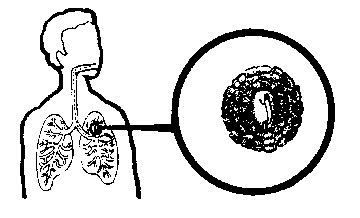
Tuberculosis (TB) is an infectious disease that is caused by the bacteria known as Mycobacterium tuberculosis. The bacterium usually attacks the lungs but can attack other areas such as the brain, kidney, bones, and joints. It often takes a while for the disease to spread to these parts because its general growth rate is slow. In the last decade, tuberculosis (TB) has caused nearly three million deaths annually, making it one of the most deadly diseases in the world. One of the major problems of Tb is that most of its 8.8 million new cases, are between the economically productive age of 15 to 49 years. To be exact about 80% are between the ages of 15 and 49.
TB is caused by a species of bacteria called Mycobacterium tuberculosis. Most people who are infected with TB bacteria do not develop active TB; that is, they do not become sick and usually do not infect others. Their body defenses control the infection by building a wall around the bacteria. However, the walling-in process does not kill the bacteria. If you are infected and later become weak, ill, or undernourished, you may start having active TB. Even if someone becomes infected with tuberculosis, that does not mean they will get TB disease. Most people who become infected do not develop TB disease because their body's defenses protect them. Experts believe that about 10 million Americans are infected with TB germs. Only about 10 percent of these people will develop TB disease in their lifetime. The other 90 percent will never get sick from the TB germs or be able to spread them to other. The death rate has slowly been increasing because of new forms of the Multidrug-resistant TB (MDRTB). The multidrug-resistant TB causes death rates from 50% to 80%. Not only does it have a high death rate it takes only about 4 to 16 weeks from diagnosis to death. It is not only more deadly, but it is becoming increasingly harder for doctors to diagnose the problem because it moves so fast. MDRTB is much different than the conventional TB. The problem with the MDRTB strain is that if they are exposed to a single effective anti-TB medication, the predominant bacilli, sensitive to that drug, are killed; the few drug resistant mutants, likely to be present if the bacterial population is large, will, multiply freely. Since it is very unlikely that a single bacillus will spontaneously mutate to resistance to more than one drug, giving multiple effective drugs simultaneously will inhibit the multiplication of these resistant mutants. This is why it is absolutely essential to treat TB patients with the recommended four drug regimen of isoniazid, rifampin, pyrazinamide and ethambutol or streptomycin. This sort of treatment is very rare though because doctors have trouble diagnosing tuberculosis and when they do they are not sure if they should prescribe all of the drugs.
TB is mainly contracted through the air. They can do this if someone coughs, sneezes or even laughing. The droplets contain the bacteria that might stay in the air for a while until someone accidentally breaths it in. TB is usually contracted if someone with the active disease is around for long exposure. People who contract large amounts of the bacteria are the ones who usually become ill. TB is very contagious but it is very hard for it to start actually showing symptoms in a person. The symptoms of tuberculosis are fatigue, weight loss, loss of appetite, a low fever, sweating at night, joint pain, and a cough that is dry in the beginning but later produces sputum. Sputum is a material that is coughed up that usually contains mucus and sometimes blood. These are the usual symptoms but sometimes may show no sign of the symptoms and kill someone.
TB can be checked in many ways. One way is that a doctor can inject a substance called tuberculin, or PPD. A lump will form on the place where you received the shot, most likely on the arm, if you are infected with TB. This reaction is called a positive tuberculin test. It means that TB bacteria have invaded your body, but it does not always mean that tuberculosis has become active in your body. More than often the tuberculosis is not active, even if a person has tested positive.
Return to Bacterial Disease Page